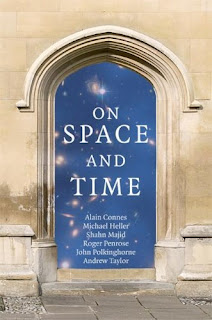 The problem with Christmas is that it interferes with the right to freedom of mobility. Hence, as Yuletide approaches each year, I initiate a search programme to find a book or paper of depth, clarity, originality, and elegance, which will sustain me through this bleak period. This year, I was amply rewarded when I discovered On Space and Time, a collection of essays at the interface between physics and philosophy, a matter of days before 'festive' ground-zero.
The problem with Christmas is that it interferes with the right to freedom of mobility. Hence, as Yuletide approaches each year, I initiate a search programme to find a book or paper of depth, clarity, originality, and elegance, which will sustain me through this bleak period. This year, I was amply rewarded when I discovered On Space and Time, a collection of essays at the interface between physics and philosophy, a matter of days before 'festive' ground-zero.The book contains lengthy articles by Shahn Majid on duality and self-duality, and Alain Connes on his non-commutative approach to space-time and particle physics, but the outstanding contribution is a 50-page exposition from Roger Penrose of his conformally cyclic cosmology.
With the apparent discovery of dark energy, and the accelerating expansion of the universe, the far future of our universe is representable by de Sitter space-time. Penrose noticed that the future conformal boundary of de Sitter space-time is spacelike, hence it can be joined to the spacelike initial conformal boundary of a Friedmann-Robertson-Walker ('Big Bang') model. The fact that the universe is very small and hot at the beginning, and very large and cold in the far future, is not a problem, argues Penrose, because both the early universe and far future universe contain only conformally invariant, massless particles. Without massive particles, there is no way of defining lengths or times, hence the only physically meaningful structure is the conformal structure, i.e., the causal structure. By compressing the conformal factor towards the far future, and expanding it towards the beginning, the geometry of the future conformal boundary can be joined seamlessly to the initial conformal boundary.
Penrose proposes that the far future of our universe contains only electromagnetic radiation and gravitational radiation. The electromagnetic radiation comes from the cosmic background radiation of the Big Bang, from stars, and from the eventual evaporation of black holes. The gravitational radiation, meanwhile, comes mostly from the coalescence of black holes. Penrose proposes that massive particles such as electrons, either annihilate with massive particles of opposite charge (positrons), or decay by some as-yet undiscovered mechanism.
The cycle of Penrose's model is one in which the universe 'begins' in a conformally invariant state, with zero Weyl curvature, but in which there is a normal derivative to the Weyl curvature. This seems to trigger the formation of massive particles. The matter then clumps together into stars and galaxies, such clumping increasing the Weyl curvature and decreasing the Ricci curvature. Eventually, much of the matter is swept into black holes, where the Weyl curvature diverges, but the Ricci curvature is zero. The matter which isn't swept into black holes decays or annihilates into radiation, and the black holes eventually evaporate themselves into radiation. The Weyl curvature thereby returns to zero, all particles are massless again, and conformal invariance resumes. Gravitational radiation, however, never thermalizes, and this appears to be responsible for the normal derivative to the Weyl curvature, which triggers the formation of massive particles in the next cycle.
Two potential problems spring to mind. Firstly, following an argument by Gibbons and Hawking, de Sitter space-time is widely believed to possess a minimum temperature due to its cosmological constant. With the value of the cosmological constant we observe, this temperature is about 10-30 Kelvin. A black hole will only evaporate if the temperature of its horizon is greater than the temperature of surrounding space. The temperature of a black hole is inversely proportional to its mass, and a black hole which grows large enough that its temperature drops below 10-30 Kelvin would never evaporate. However, such a black hole would have a mass approximately equal to the current observable universe, so the formation of such a black hole may well be impossible in a universe whose contents are diluted by the accelerating expansion of dark energy.
The second problem is that if the quantum fields in the far future of our universe can be treated as quantum fields in thermal equilibrium in de Sitter space-time, then because such a universe is eternal, quantum fluctuations ensure the spontaneous generation, at a constant rate, of anything you care to name, including massive particles and black holes. This would prevent our universe from ever reaching an exact state of conformal invariance in the far future. However, because gravitational radiation never reaches thermal equilibrium, one could perhaps argue that the quantum fields in the far future of our universe cannot be treated as quantum fields in thermal equilibrium in de Sitter space-time.
Penrose's proposal remains fascinating and elusive. A perfect antidote to Christmas.
Roger Penrose Conformally cyclic cosmology





















